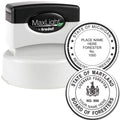Have you ever stared at a stack of plain T-shirts, tote bags, or even baby clothes and wished you could personalize them with an easy, standout design? A cloth marking stamp can be exactly what you need. Whether you want to label your quilting squares, jazz up a denim jacket, or keep track of your kids’ clothes, this simple yet powerful tool helps you transform an otherwise ordinary item into something unique. From quick labeling to full-on design flair, it’s the ultimate companion for anyone who loves crafting, sewing, or even just staying organized.
In this guide, you’ll discover how these stamps work, how to choose or create your ideal design, and tips for getting crisp, long-lasting imprints. You’ll also learn why so many creative crafters and busy parents look to ESS for all their fabric stamping needs. Ready to dive into the world of customizing fabric with minimal fuss? Let’s get started.
Understand Cloth Marking Stamps
Cloth marking stamps are specialized rubber stamps that transfer ink directly onto fabrics. The ink seeps into the fibers, creating a clear, permanent imprint that’s resilient enough to handle repeated washes. You’ve probably used a standard stamp on paper, but once you switch to a fabric-specific stamp, you’ll quickly realize that not all stamping processes are created equal.
Why Use a Cloth Marking Stamp?
- Labeling Clothing: Keep track of kids’ outfits, sports uniforms, or costume pieces without wrestling with iron-on labels.
- Personalizing Gifts: Add a name or signature artwork to tote bags, T-shirts, or quilts, turning them into heartfelt keepsakes.
- Branding Products: If you sell handmade fabrics, crocheted scarves, or custom items, a dedicated stamp is a fast way to brand your work with your logo.
- Quick Organization: Mark pillowcases, towels, or daily linens so everyone knows which item is theirs.
Imagine how simple it is to tap your stamp onto an ink pad, line up your fabric, and press. No sewing, no fuss, and no second-guessing your freehand calligraphy. The right stamp will give you a neat, consistent look every time.
Differences From Regular Stamps
You might be wondering if you can repurpose a normal office or craft stamp for your fabric. In many cases, these non-fabric stamps simply won’t stand up to washing and everyday wear. A cloth marking tool often uses specialized materials and inks designed to bond with fabric fibers:
- Deeper Etching: Fabric stamps may feature deeper carved rubber, ensuring smooth coverage on textured surfaces.
- Specific Ink Types: These are formulated to resist fading or smudging when exposed to water, heat, or friction.
- Sturdy Mounts: Some come with wooden or acrylic handles engineered to handle repeated pressing on thicker textiles.
As soon as you watch the ink set into your cloth, you’ll see why a dedicated cloth marking stamp is worth the investment.
Choose the Best Materials
When exploring your options for a dependable stamp, it’s helpful to know what materials can hold up to frequent inking and washing. Your chosen stamp’s construction, along with its handle and rubber, can influence how your design appears and how long it lasts.
Rubber Types and Handles
Rubber is the heart of any marking stamp, so understanding the variations is key:
- Natural Rubber: Known for its durability, it withstands repeated use and stays flexible, providing clean transfers onto different types of cloth.
- Photopolymer: Sometimes used for custom stamps because it’s easier to shape into intricate designs, though it may wear out quicker than rubber if used daily.
- Acrylic Mounts: These transparent blocks let you see exactly where you’re stamping, reducing alignment errors.
- Wood Handles: Classic choices offering a comfortable grip. Some crafters love the vintage look of a wooden block stamp.
An ergonomic handle does more than just look good. It helps you maintain consistent pressure, preventing uneven spots or blurry edges. If you’re creating multiple pieces in a single session, comfort can make all the difference.
Match the Stamp to Your Fabric
Different fabrics can affect how your stamp’s image turns out. Here’s a quick table to help you gauge what might work best, depending on your project:
| Fabric | Recommended Approach |
|---|---|
| Cotton | Use a permanent fabric ink pad |
| Linen | Pre-wash to remove sizing, then stamp |
| Denim | Choose bold ink colors |
| Satin or Silk | Use gentle pressure, allow extra drying |
| Canvas | Ink deeply to avoid faint prints |
Before you commit to a large project, do a quick test on a fabric scrap. This helps you fine-tune your technique (and avoid any oh-no moments on your final piece).
Considering the Fabric Stamp Alternative
If you’re looking for an all-in-one solution, you’ve probably heard about the “fabric stamp” variety. Similar in concept, it’s a neat style of stamp that often uses specially blended inks for long-lasting impressions on clothes and other textiles. Whether you opt for a cloth marking stamp with a wood handle or a fully contained fabric-focused option, you’ll end up with a design that’s durable, professional-looking, and made to stand out.
Work With the Right Ink
Now that you’ve picked a reliable stamp, the ink you choose can make or break your final result. Some inks are watery and fade after a single wash, while others can be thick or seep through your material. Getting the right formula is crucial.
Fabric vs. All-Purpose Inks
- Fabric Inks: Specifically formulated to adhere to textiles, these inks won’t crack or peel once they’re heat-set. If you’re new to stamping, look for “permanent on fabric” labeling on the kit.
- All-Purpose Pigment Inks: Often used for both paper and fabric surfaces; however, they may still require heat-setting. These can work well for lighter projects or items you don’t plan to wash often.
To lock in your design, many fabric inks recommend a quick pass with an iron or a brief tumble in the dryer. This heat-setting process helps the ink penetrate the fibers, resulting in a lasting imprint.
Handling Ink Pads
Ink pads come in various sizes, textures, and saturation levels. The pad should be large enough to accommodate your stamp, so you’re not awkwardly running the stamp’s edges off the pad. You can also consider re-inking pads once they begin to dry.
When applying ink to your stamp, tap it gently a few times to ensure an even coat. Press too hard, and you’ll flood the rubber’s crevices. Press too lightly, and your image may look patchy. You’ll find that sweet spot with a bit of practice.
Make Your Creative Ideas Pop
A cloth marking stamp isn’t just about labeling your clothes. It’s a gateway to endless personalization. You can incorporate multiple colors, layered designs, or even experiment with different surfaces until you find a style you love.
Layering and Blending Techniques
Feeling adventurous? Rather than sticking to one color, try layering two or three shades:
- Stamp your first color and allow it to dry.
- Place a second color on top or just offset from your original impression for a drop-shadow effect.
- Experiment with metallic or glittery inks for special events, like holiday-themed gifts.
Build your confidence with smaller test prints. Once you get a sense of which combinations pop best, you’ll have a brand-new approach to plain T-shirts or tote bags.
Mixing Stamping With Other Crafts
You don’t have to stop at stamping when you’re sprucing up fabric. Pair your favorite cloth marking designs with:
- Embroidery: Stamp a delicate outline and then stitch over certain lines for texture or color accents.
- Fabric Paint: Create bold blocks of color, then stamp text or silhouettes on top.
- Appliqué: Adhere fabric cutouts in fun shapes for a layered, multidimensional look.
Think of stamping as the crucial first step that sets your project’s theme. Afterward, you can bring extra life to it with stitches, patches, or a quick flick of fabric-safe paint.
Why Trust ESS
When it’s time to pick out a stamp, you’ll find plenty of options, but ESS stands out for a few compelling reasons. As a family-owned and operated business since 1964, we’ve spent over 60 years perfecting cloth marking stamps, clothes name stamps, and every variation in between. We know what it takes to balance quality, longevity, and ease of use.
Stellar Customer Service and Fast Turnaround
We believe in treating every crafter, small business, or hobbyist like a part of our extended family. That means if you call us with special requests or questions, we’ll take the time to offer personalized support. Our top priority is making your stamping experience smooth, from browsing to finalizing your order.
- Exceptional Guidance: Unsure which size or ink you need? Our team can walk you through the choices, saving you guesswork.
- Fast Shipping: Rushing for a deadline? We pride ourselves on super speedy turnaround so you can get stamping as soon as possible.
High-Quality Construction
An ESS stamp is built to last, using robust materials that can endure frequent pressing, inking, and washing. You’ll see the difference in crisp lines, reliable coverage, and designs that stay vibrant over time. When your creative projects rely on consistent results, the right tool makes all the difference.
FAQs
Below are some of the most common questions people have when shopping for a cloth marking solution. Check them out, and if you still have any doubts, feel free to reach out.
Can I Wash Stamped Fabric in Hot Water?
Yes. Many stamping inks, especially those labeled as “permanent on fabric,” withstand hot water once they’re heat-set. Always follow the ink manufacturer’s recommendation for best results.How Long Do ESS Stamps Last?
With proper care, a high-quality rubber stamp can last for years. Wipe off excess ink, store it away from direct sunlight, and you’ll enjoy thousands of impressions before any noticeable wear.Do I Need Special Ink for Dark Fabrics?
Dark fabrics often need brighter or opaque inks. Look for pigment inks specifically formulated for deeper colors, or try a specialty white ink if you want crisp text and designs on a black or navy cloth.Can I Personalize an ESS Stamp?
Absolutely. ESS can help you create custom stamps featuring names, logos, or playful icons. Just let us know your idea, and we’ll produce a design that matches your vision.Is It Difficult to Align the Stamp Perfectly?
Practice makes perfect. You can line up the edges with a ruler, or opt for an acrylic mount so you can see exactly where you’re stamping. Try a few test prints on scrap fabric to gain confidence.
Feel free to explore your creative impulses, mix various ink colors, or test out layering techniques for that wow factor. With a sturdy cloth marking stamp in your craft kit, it’s easier than ever to personalize, organize, or brand your fabrics. You’ll spend less time fussing over messy markers or iron-on labels and more time enjoying the finished piece. And if you’re still unsure, remember that ESS is just a phone call or email away. We’re always excited to help you find the perfect stamp for your project needs. Happy stamping!


















